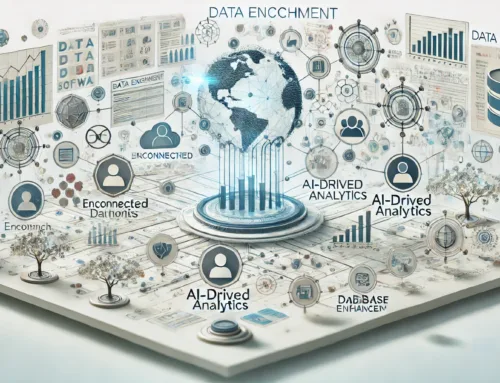You’ve likely heard that effective data enrichment is crucial for informed decision-making and targeted strategies. But what exactly are the 10 best practices that can take your data enrichment efforts to the next level? From regular data audits to leveraging AI and predictive analytics, each practice plays a vital role in optimizing your data quality and accuracy. By exploring these strategies, you can unlock the full potential of your data enrichment processes and stay ahead in today’s data-driven landscape.
Regular Data Audits
Regular data audits are a crucial component of effective data enrichment strategies. Ensuring data accuracy and consistency is paramount in maintaining the quality and reliability of your database. By conducting regular audits, you can identify and rectify any inaccuracies or inconsistencies that may have crept in over time.
Data accuracy is essential for making informed business decisions. Inaccurate data can lead to costly mistakes and misinformed strategies. By regularly auditing your data, you can verify the correctness of information, such as contact details, purchase history, or demographic data. This verification process enhances the overall quality of your database, minimizing the risk of errors impacting your operations.
Moreover, data consistency is key to establishing trust in your data. Inconsistencies, such as duplicate entries or varying formats, can hinder data analysis and reporting. Through audits, you can standardize data formats, eliminate duplicates, and ensure uniformity across all records. This consistency streamlines data processing and enhances the effectiveness of your data enrichment efforts.
Quality Control Measures
To ensure the reliability and accuracy of your enriched data, implementing robust quality control measures is imperative. Utilizing data enrichment automation can streamline the process and reduce the likelihood of errors, ensuring a higher level of data enrichment accuracy. By automating tasks such as data matching, cleansing, and appending, you can standardize and validate incoming data, leading to improved overall data quality.
Implementing data validation checks at various stages of the enrichment process is crucial. These checks can include verifying the integrity of incoming data, ensuring consistency across datasets, and flagging any anomalies for manual review. This proactive approach helps in identifying and rectifying errors early on, minimizing the impact on the final enriched dataset.
Regularly monitoring and evaluating the performance of your data enrichment processes is also key to maintaining high data enrichment accuracy. By tracking key metrics such as match rates, duplicate records, and enrichment success rates, you can identify areas for improvement and make necessary adjustments to enhance the overall quality of your enriched data.
Ensuring Data Privacy
Ensuring data privacy is a critical aspect of any data enrichment process. To safeguard sensitive information, consider the following best practices:
- Implement Strong Encryption Methods: Utilize advanced encryption techniques to protect data both at rest and in transit.
- Adhere to Data Governance Policies: Establish clear guidelines for how data should be handled, accessed, and shared throughout the enrichment process.
- Comply with Applicable Regulations: Stay up-to-date with data privacy laws and industry standards to ensure compliance with legal requirements.
- Ensure Secure Data Transmission: Use secure channels and protocols when transferring data between systems to prevent unauthorized access or interception.
Using Reliable Data Sources
To ensure the quality of your enriched data, it is crucial to carefully evaluate the reliability of your data sources. The importance of a robust verification process cannot be overstated in guaranteeing the accuracy and relevance of the information you incorporate. Embracing a diverse range of reputable sources can enhance the depth and breadth of insights gained from your data enrichment efforts.
Source Data Quality
Quality data is the cornerstone of any successful data enrichment process. Ensuring the reliability and accuracy of your source data is crucial for effective enrichment strategies and validation of results. When it comes to enhancing your data, consider the following key points:
- Source Data Assessment: Conduct a thorough evaluation of your existing data sources to identify any gaps or inconsistencies that may impact the enrichment process.
- Enrichment Techniques: Utilize advanced enrichment techniques such as data normalization, deduplication, and data appending to enhance the quality and completeness of your dataset.
- Accuracy Validation: Implement validation checks and quality control measures to verify the accuracy of the enriched data and minimize errors in your final dataset.
- Continuous Monitoring: Regularly monitor and update your enriched data to ensure its ongoing accuracy and relevance for your business operations.
Verification Process Importance
Reliable data sources play a pivotal role in the verification process, underpinning the integrity of your enriched dataset. When enriching your data, ensuring data accuracy is paramount. Utilizing trusted sources helps validate the information, safeguarding against errors that could compromise the quality of your dataset.
The validation process hinges on the credibility of the data sources you choose. By cross-referencing information from reputable sources, you can verify the accuracy of the data and enhance its reliability. This meticulous validation ensures that the enriched data is not only comprehensive but also trustworthy for decision-making processes.
Incorporating a rigorous validation process into your data enrichment strategy guarantees that the data you rely on is accurate and up-to-date. By utilizing multiple reliable sources, you can mitigate the risk of inaccuracies and inconsistencies, thereby fortifying the foundation of your enriched dataset. Embracing the importance of verification through reliable data sources is key to enhancing the overall quality and usability of your enriched data.
Diversity in Sources
Utilizing a diverse range of reliable data sources is imperative for ensuring the accuracy and credibility of the enriched dataset. When considering data enrichment techniques, the importance of diversity in sources cannot be overstated. Here’s why:
- Enhanced Accuracy: Drawing from various reputable sources helps in cross-referencing and validating data points, reducing the risk of errors.
- Improved Completeness: Different sources provide unique insights and information, enriching the dataset with a wider scope of details.
- Increased Reliability: Relying on a single source can introduce bias or inaccuracies, while multiple sources enhance the credibility of the enriched data.
- Better Decision-Making: Diverse data sources offer a more comprehensive view, aiding in making informed decisions based on a well-rounded perspective.
Consistent Data Updates
To ensure the accuracy and relevance of your data, maintaining consistent updates is paramount. Data governance plays a crucial role in setting the guidelines and protocols for updating data regularly. By implementing robust data governance practices, you can establish clear responsibilities and processes for keeping your data accurate and up to date. Additionally, incorporating data validation techniques ensures that the updates made to your data are error-free and reliable.
Regular data updates not only enhance the quality of your database but also support better decision-making processes. When your data is consistently updated, you can rely on it to provide current insights and support strategic initiatives effectively. Moreover, staying proactive in updating your data helps prevent inaccuracies or outdated information from affecting your analyses and business operations.
Segmentation and Personalization
Ensuring your data is consistently updated sets the foundation for effective segmentation and personalization strategies. To effectively target your audience and maximize engagement, consider the following:
- Understand Your Audience: Use data segmentation to divide your audience into specific groups based on demographics, behavior, or preferences.
- Personalize Content: Leverage customization options to tailor messaging, offers, and experiences to different segments of your audience.
- Implement Dynamic Content: Incorporate dynamic content based on user behavior or demographics to enhance personalization efforts.
- Optimize Campaigns: Continuously analyze segmentation and personalization results to refine strategies and improve engagement with your target audience.
Leveraging AI and Machine Learning
When looking to enhance data enrichment strategies, leveraging AI and machine learning can provide invaluable insights and efficiencies. Automation benefits are abundant when utilizing AI and machine learning in data enrichment processes. These technologies can automatically analyze vast amounts of data at a rapid pace, identifying patterns and trends that human analysis may overlook. By automating tasks such as data categorization, normalization, and matching, organizations can save time and resources while improving the overall quality of enriched data.
Moreover, AI and machine learning contribute significantly to data accuracy advancements. These technologies can detect errors, inconsistencies, and anomalies in datasets, ensuring that the enriched data is reliable and up-to-date. By continuously learning from data patterns and feedback, AI systems can enhance their accuracy over time, leading to more precise data enrichment outcomes.
Incorporating AI and machine learning into data enrichment processes not only streamlines operations but also enhances the quality and reliability of enriched data, making it a crucial component of a successful data enrichment strategy.
Cross-checking Data
Having established the significance of leveraging AI and machine learning in data enrichment processes, the focus now shifts towards the critical aspect of cross-checking data. Ensuring data accuracy and validity is paramount in effective data enrichment strategies. Here are four key points to consider when cross-checking data:
- Data Validation: Implementing robust data validation processes helps in identifying and correcting errors or inconsistencies within the dataset.
- Cross-Referencing: Cross-checking data against multiple reliable sources helps in verifying the authenticity and accuracy of the information.
- Duplicate Detection: Identifying and eliminating duplicate entries is essential to maintain data integrity and prevent inaccuracies.
- Consistency Checks: Conducting consistency checks ensures that the data is coherent across different fields and databases, enhancing overall accuracy.
Utilizing Predictive Analytics
Leveraging predictive analytics is a pivotal component in enhancing data enrichment strategies. By utilizing predictive analytics, you can significantly improve performance optimization and enable data-driven decision-making processes. Predictive analytics leverages historical data, statistical algorithms, and machine learning techniques to identify patterns and predict future outcomes accurately.
Through predictive analytics, organizations can gain valuable insights into customer behavior, market trends, and potential risks. These insights empower businesses to make informed decisions based on data-driven forecasts rather than relying solely on intuition or past experiences. By integrating predictive analytics into data enrichment strategies, companies can enhance the accuracy and reliability of their data, leading to more effective decision-making processes.
Furthermore, predictive analytics can help businesses identify new opportunities for growth and innovation by analyzing trends and forecasting potential outcomes. This proactive approach allows organizations to stay ahead of the competition and adapt quickly to changing market dynamics. In essence, leveraging predictive analytics is essential for organizations looking to optimize performance and excel in data-driven decision-making.
Integrating Data Across Platforms
When integrating data across platforms, ensuring compatibility between systems is crucial for seamless data flow. Effective data mapping strategies help in structuring information in a unified format for easy interpretation and analysis. By employing cross-platform integration techniques, you can streamline data processes and enhance overall operational efficiency.
Platform Compatibility Tips
To seamlessly integrate data across platforms, it is crucial to prioritize compatibility. Ensuring that the systems can effectively communicate and share information is key to successful data enrichment. Here are some platform compatibility tips to enhance your data integration process:
- Standardize Data Formats: Utilize common data formats like CSV, XML, or JSON to facilitate smooth data migration and platform integration.
- API Utilization: Implement APIs for seamless data exchange between different platforms, enabling real-time updates and synchronization.
- Testing Across Platforms: Conduct thorough testing to check compatibility and data consistency across all integrated platforms.
- Version Control: Maintain version control to track changes and updates across platforms, ensuring data accuracy and preventing conflicts.
Data Mapping Strategies
For effective data enrichment through integrating data across platforms, a vital aspect to consider is data mapping strategies. Data mapping involves aligning data fields from different sources to ensure seamless communication and compatibility. When implementing data mapping strategies, two key processes play a crucial role: data validation and data cleansing.
Data validation is essential in data mapping to ensure that the information transferred between platforms is accurate, consistent, and meets the required standards. By validating data during the mapping process, you can identify and rectify any discrepancies or errors, ensuring the reliability of the enriched data.
Similarly, data cleansing is a fundamental step in data mapping that involves detecting and correcting any inaccuracies, inconsistencies, or duplications within the data. By cleansing the data before mapping it across platforms, you can improve data quality and prevent issues that may arise from transferring flawed information.
Cross-Platform Integration Techniques
Implementing effective cross-platform integration techniques is crucial for seamlessly integrating data across various platforms. When it comes to cross-platform data enrichment, utilizing the right strategies ensures smooth data flow and consistency. Here are some key techniques to consider:
- Data Mapping Techniques: Employ advanced data mapping tools to establish clear connections between different data sets and platforms.
- Platform Integration: Integrate various platforms using APIs or middleware to enable seamless data transfer and synchronization.
- Consistent Data Formatting: Ensure data is formatted consistently across all platforms to avoid compatibility issues and data discrepancies.
- Real-Time Data Sync: Implement real-time syncing mechanisms to keep data up-to-date across platforms and provide users with the most current information.
Frequently Asked Questions
How Can Data Enrichment Improve Customer Retention Rates?
To improve customer retention rates, data enrichment enables personalized communications and enhanced segmentation. By understanding customer preferences and behaviors accurately, you can tailor interactions effectively, increasing engagement and loyalty. This leads to stronger relationships and higher retention rates.
What Are the Common Challenges Faced During Data Enrichment Processes?
During data enrichment, you may encounter challenges like ensuring data accuracy from diverse sources. It’s crucial to address inconsistencies early on to prevent skewed insights. Stay vigilant in validating and integrating data for reliable outcomes.
Is There a Recommended Frequency for Updating Enriched Data?
To maintain data accuracy, consider the update frequency for enriched data. Utilize data enrichment tools strategically and follow best practices for timely updates. Regularly refreshing enriched data ensures relevance and enhances decision-making capabilities within your organization.
How Can Data Enrichment Impact Sales and Marketing Strategies?
Data enrichment can significantly impact sales and marketing strategies by improving lead generation and enhancing target profiling. By adding valuable insights to your existing data, you can better identify potential customers and tailor your approach for higher conversion rates.
What Are the Key Metrics to Measure the Success of Data Enrichment Efforts?
To measure the success of data enrichment, focus on measuring ROI and ensuring accuracy. Track metrics like increased conversion rates, improved lead quality, and enhanced customer segmentation. These indicators will help you gauge the effectiveness of your efforts.




